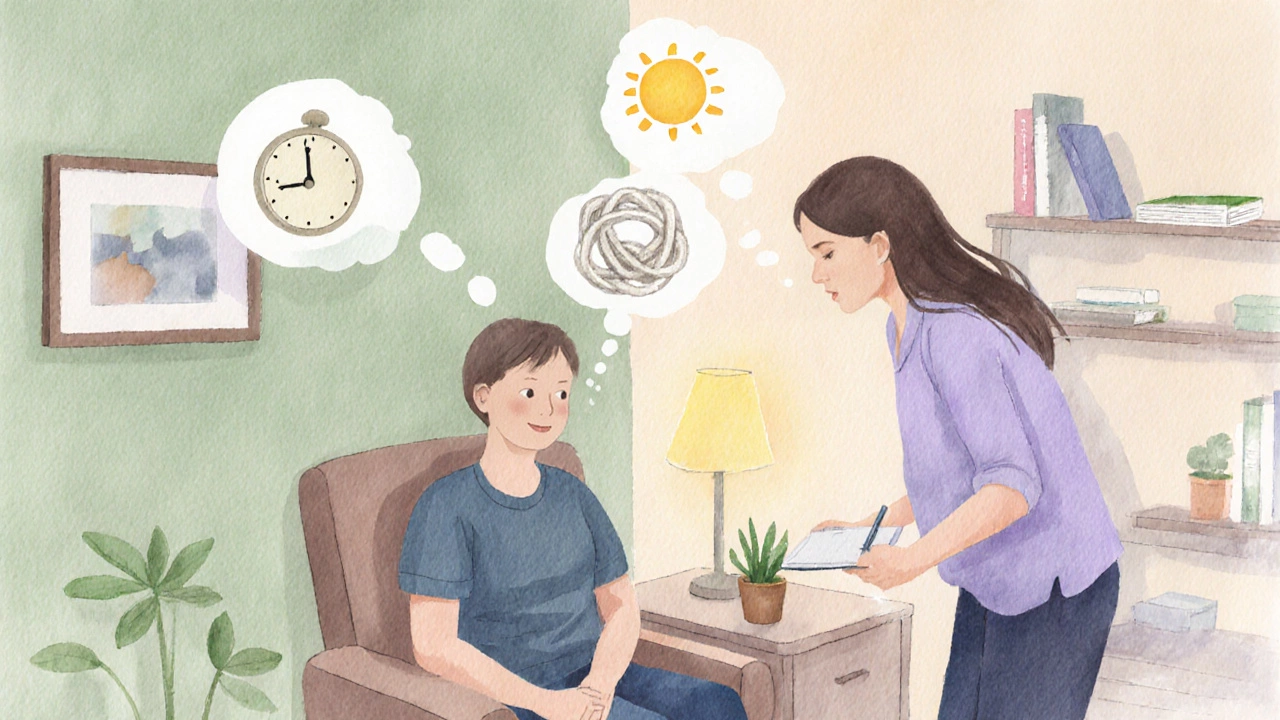Therapy Readiness Self-Assessment
Instructions
Answer the following questions honestly. Each 'Yes' response adds one point. A score of 2 or more suggests you may benefit from speaking with a mental health professional.
Quick Takeaways
Feeling stuck, overwhelmed, or constantly sad? Those feelings might be more than just a bad day. Below are the key red flags that suggest it’s time to talk to a professional.
- Persistent low mood lasting weeks or months
- Unmanageable anxiety or panic attacks
- Changes in sleep, appetite, or energy that don’t improve
- Strained relationships or social isolation
- Thoughts of self‑harm or hopelessness
If any of these resonate, consider reaching out for therapy.
Recognizing the Signs That Therapy May Help
Everyone experiences stress, but when stress turns into a daily grind, it can erode your mental health. Here are the most common signals that your mind is asking for extra support.
Depression is a mood disorder marked by persistent sadness, loss of interest, and fatigue. According to the World Health Organization, more than 264 million people worldwide live with depression, and many never receive treatment.
Anxiety encompasses worry, tension, and physical symptoms like a racing heart. When anxiety spikes into panic attacks or interferes with work, it’s a clear sign that professional help could restore balance.
Other tell‑tale signs include:
- Difficulty concentrating or making decisions
- Frequent mood swings or irritability
- Increased use of alcohol, drugs, or other coping mechanisms
- Physical symptoms with no medical cause-headaches, stomachaches, or chronic pain
These patterns often overlap. If you notice two or more persisting for more than two weeks, it’s time to act.
Understanding What Therapy Offers
Therapy isn’t just talking about your problems; it’s a structured, evidence‑based process that helps you develop coping skills, reframe negative thoughts, and set realistic goals.
Cognitive Behavioral Therapy (CBT) is one of the most researched approaches. CBT teaches you to identify distorted thinking patterns and replace them with healthier alternatives, leading to measurable symptom reduction within weeks.
Mindfulness‑Based Therapy integrates meditation and present‑moment awareness to lower stress and improve emotional regulation. Studies show a 30% reduction in anxiety scores after eight weeks of guided mindfulness.
Beyond specific techniques, therapy provides:
- A safe, confidential space to explore emotions
- Professional validation that normalizes your experience
- Tailored strategies that fit your lifestyle and culture
These benefits often ripple out to improve sleep, relationships, and work performance.

Deciding If Therapy Is Right for You
Choosing to start therapy is a personal decision, but you can run a quick self‑check:
- Do you feel stuck despite trying self‑help methods?
- Are your symptoms affecting daily functioning?
- Do you have a support network that can’t fully address your concerns?
If you answered “yes” to two or more, therapy is likely a good next step. Remember, seeking help is a sign of strength, not weakness.
Picking the Right Therapist
The therapist‑client fit matters as much as the therapy type. Here’s how to narrow down options.
Therapist is a licensed mental‑health professional who provides counseling, psychotherapy, or specialized interventions. Credentials vary by region-check for registration with the Indian Psychiatric Society or a recognized counseling board.
Key criteria to evaluate:
- Specialization: Does the therapist focus on depression, anxiety, trauma, or couples counseling?
- Approach: Are they trained in CBT, dialectical behavior therapy (DBT), or psychodynamic methods?
- Cultural competence: Will they respect your background, language preferences, and values?
- Logistics: Office location, tele‑therapy availability, session length, and fees.
Many therapists offer a free 15‑minute introductory call. Use it to gauge comfort level-your gut feeling is a reliable guide.
Starting Your First Session
Walking into a therapist’s office can feel intimidating. Here’s a step‑by‑step plan to make the experience smoother.
- Schedule and confirm: Note the appointment date, time, and virtual link (if applicable). Set a reminder.
- Prepare a brief overview: Jot down the main issues you want to discuss-symptoms, triggers, recent changes.
- Bring insurance info (if relevant): Verify coverage or ask about cash‑pay rates.
- Arrive early: Use the extra minutes to settle, practice deep breathing, and note any immediate feelings.
- Be honest: Therapists can’t help if you hold back. Remember, confidentiality is legally protected.
After the session, reflect on how you felt. Did the therapist seem empathetic? Were the questions relevant? This feedback helps you decide whether to continue or try another professional.
Common Concerns and How to Handle Them
It’s normal to have doubts before committing to therapy. Below are frequent worries and practical responses.
Stigma still exists in many communities, especially around mental‑health treatment. Sharing your decision with trusted friends or reading stories of public figures who benefited from therapy can normalize the experience.
Cost can be a barrier. Look for sliding‑scale options, government‑run mental‑health clinics, or Employee Assistance Programs (EAP) that cover sessions at no out‑of‑pocket expense.
Time commitment is another concern. Short‑term therapy (6‑12 sessions) often yields measurable progress, and many therapists now offer evening or weekend slots.
Lastly, fear of “talking about the past” can feel overwhelming. Modern therapists use present‑focused techniques that prioritize coping skills over deep‑dive analysis, allowing you to progress at a comfortable pace.
Checklist Before You Book
| Item | Why It Matters |
|---|---|
| Identify primary concern(s) | Helps therapist tailor the treatment plan |
| Research therapist credentials | Ensures qualified, ethical care |
| Confirm insurance or payment method | Avoids surprise bills |
| Check availability (in‑person or telehealth) | Fits therapy into your schedule |
| Prepare questions for the intro call | Assesses comfort and fit early |
Moving Forward: Building a Sustainable Mental‑Health Routine
Therapy is a powerful tool, but lasting change often combines professional guidance with daily habits. Consider adding these practices:
- 10‑minute mindfulness meditation each morning
- Journaling thoughts and emotions before bed
- Regular physical activity-walks, yoga, or sports
- Connecting with supportive friends or family
- Periodic “therapy check‑ins” to reassess goals
When you combine therapy with self‑care, you create a feedback loop that reinforces progress and reduces the chance of relapse.
Frequently Asked Questions
How many therapy sessions do I need?
The number varies. Some people feel relief after 4‑6 CBT sessions, while others dealing with complex trauma may benefit from 12‑20 or ongoing support. Your therapist will set milestones and adjust the plan as you progress.
Can I switch therapists if I don’t feel comfortable?
Absolutely. A good therapeutic relationship hinges on trust. Most clinics allow you to transfer your records to a new practitioner with minimal hassle.
Is online therapy as effective as face‑to‑face?
Research indicates comparable outcomes for anxiety and depression when using secure video platforms. The key is finding a licensed therapist who is comfortable delivering virtual care.
What if I can’t afford therapy?
Look for community mental‑health centers, university counseling services, or NGOs offering low‑cost sessions. Some therapists offer a sliding‑scale based on income, and tele‑therapy apps sometimes provide subsidized rates.
Do I need a diagnosis before I start therapy?
No. Many people start therapy to manage stress or life transitions without a formal diagnosis. A therapist can help you explore whether a formal evaluation is needed later.
Can therapy help with physical pain?
Yes. Chronic pain often has a psychological component. Techniques like CBT and mindfulness have been shown to reduce perceived pain intensity and improve coping.








